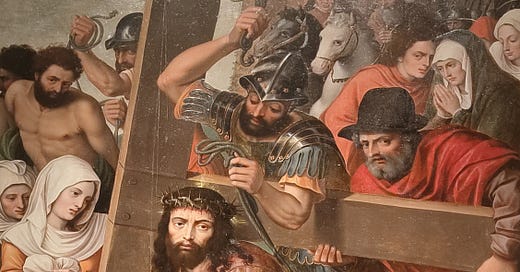Christ Bearing the Cross, by Michael Coxcie
Circa 1530. Oil on panel. Gallery of Royal Collections. Madrid.
The Gallery's website contains a very interesting explanation of this work, which is unknown to the general public:
Christ, crowned with thorns and covered in a long tunic, falls to the ground under the weight of an enormous "tau"-shaped cross, which Simon of Cyrene helps him lift, while a Roman soldier whips him with his whip (Matthew 27:32-33). Behind the group, the Virgin is consoled by Saint John, followed by one of the Marys, while the other two Marys kneel before her. In the background, another soldier leads the two thieves bound, and behind them, several Pharisees on horseback leave the walled city of Jerusalem.
The work can be stylistically classified as part of Coxcie's production before his stay in Rome, from 1530 onwards, a period strongly influenced by his teacher Bernard van Orley, one of the first Flemish painters to be influenced by the Italian Renaissance. The strongly muscled nude of one of the two thieves is very daring and demonstrates Coxcie's interest in incorporating new Italian trends in Flanders. However, the motley composition with multiple figures and the treatment of the female figures are connected to the Flemish tradition. The artist's later versions of the theme gain in emotional expressiveness, thanks to the influence of Sebastiano del Piombo, with whom he may have coincided in Rome working on the Chapel of Saint Barbara in the Church of Santa Maria dell'Anima. Thus, we move from the interpretations of Christ accompanied by a thief and executioner in the Lázaro Galdiano Museum or the Complutense University of Madrid to the solitary and grief-stricken figures in the Prado Museum, a version that Charles V possibly also took with him to his retirement in Yuste.
There is also an explanation about the author from which I will highlight this:
He achieved a certain reputation in Italy, and Giorgio Vasari recognized that Coxcie had successfully adopted the Italian style. However, Coxcie's main occupation in Rome was the design of prints, such as The Fable of Psyche (32 plates) engraved by Agostino Veneziano and Bernardo Daddi. These images in the Classical style were wrongly attributed to Raphael.
Back in the Netherlands, Coxcie joined the Guild of Saint Luke at Mechelen in 1539. Shortly after, he moved to Brussels, joining its guild (1542). He is mentioned in 1546 as painter to Mary of Hungary, aunt of Philip II, filling the vacancy left by the late Van Orley. He produced works for the Château de Binche and executed a large copy of Jan van Eyck's Ghent Polyptych for Philip II when the king became convinced that he could not acquire the original. Coxcie also replicated Rogier van der Weyden's The Descent from the Cross; when the original entered the Prado Museum, Coxcie's copy replaced it in the El Escorial monastery.
He died, almost a centenarian and still active, as a result of a fall from scaffolding.
Originally published in Wordpress.
Buy me a coffee. ☕️




